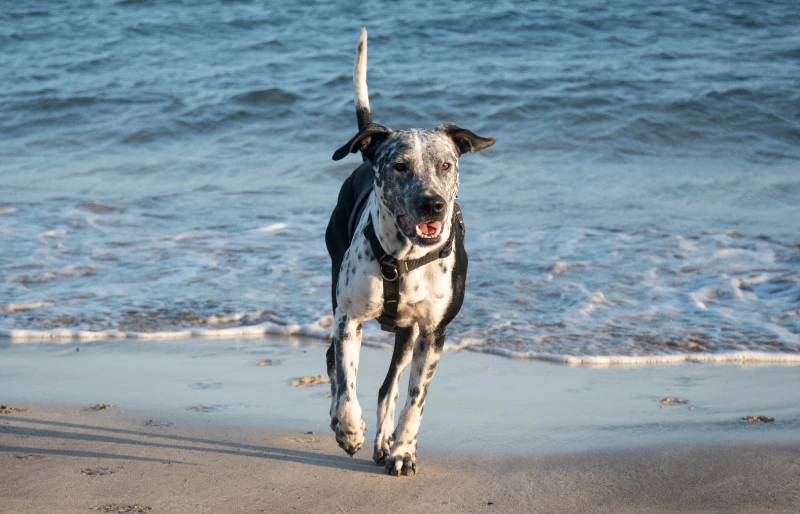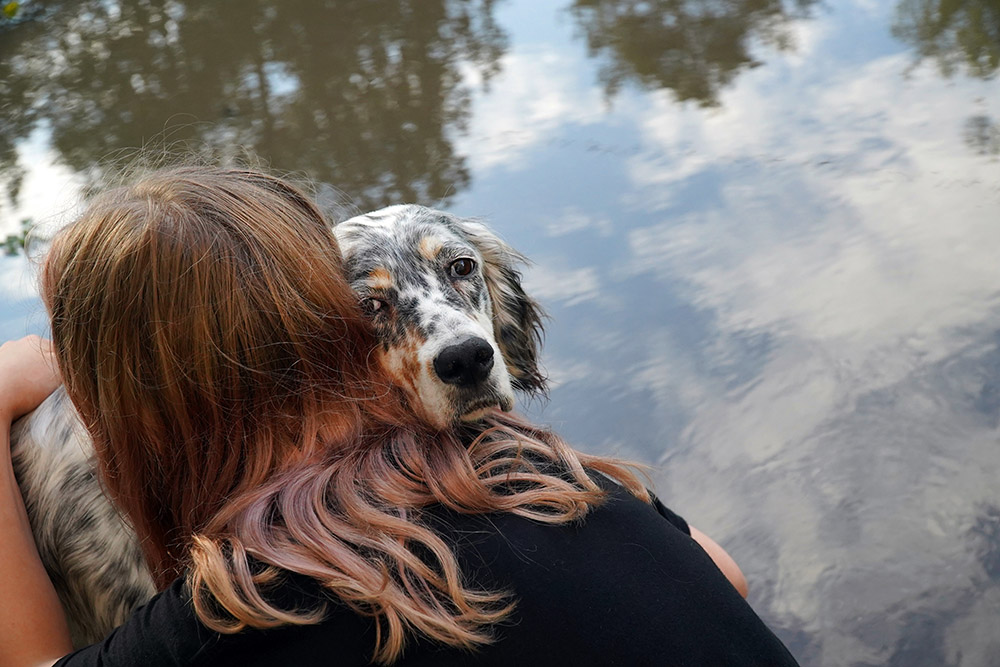In this article
I’ve had a constant group of canine companions for more than 15 years, and during that time, I have had to say goodbye to my four-legged loved ones more often than I’d like to recount. Some have succumbed to serious health conditions like cancer, and others just got old, and it was their time to move on.
My husband and I love having a pack to share our lives with, and currently, five canines are part of our household. We’ve had a total of nine dogs during the 15 years we’ve been canine caretakers, and sadly, four have left this earth, so we have experience when it comes to saying goodbye to a beloved furry family member when the time comes. The process never gets easier, but we have learned how to better make our final days and/or hours count and how to make the healing process a little less painful as time goes on. Here’s what I feel should be shared on the topic.

Assessing Your Dog’s Quality of Life
Most of the time, there are signs that a dog is nearing the end of their life, especially when it’s due to old age. However, even dogs (and other pets) that are younger can show signs of decline due to health conditions or other reasons. Then again, sometimes, there is no warning that a dog’s time with you is near the end.
Quality of life can mean different things to different people, and can be hard to measure and assess. One tool that can help you and your vet determine how your dog is doing overall is the Quality of Life scale (QOL). The HHHHHMM scale was developed by a veterinarian, and each letter stands for a different situation/issue you can address: hurt, hunger, hydration, hygiene, happiness, mobility, and “more good days than bad days.”
- Hurt: Assess their pain. Your pup is in continuous pain and is no longer responding to medications or other pain management techniques.
- Hunger: As dogs reach the end of their lives and their organs begin to shut down, their interest in food and water will fizzle out. See how much and how often they eat.
- Hydration: Is your dog drinking enough water or are they getting dehydrated.
- Hygiene: Can your dog be kept clean? Are they passing urine and feces where they are lying?
- Happiness: Dogs are likely to display behavioral changes during the last days, weeks, or even months of their life. They might become depressed, confused, or anxious in situations when they were previously comfortable. They may get restless and unable to get comfortable when they lie down. Some dogs get clingy, while others just want to isolate themselves from everyone and any activity. Many dogs also lose interest in their favorite toys and activities.
- Mobility: Many dogs lose the ability to maintain full mobility as they reach the end of their lives, whether due to pain, muscle wasting, weakness, malignancies, or lethargy. They may not be able to get up or lie down on their own, scratch their heads, or whimper when they walk.
- More good days than bad days: See how many days your dog looks like they are living life and compare it to if the dog seems to have just given up.

Looking at these issues and being honest about what your dog is going through is not easy. But it is the right thing to do to see if your dog’s quality of life has greatly decreased.
Euthanasia: Putting Your Dog to Sleep
If your dog has reached the point where their quality of life is poor, and your vet can no longer keep them comfortable and happy with medications and management, they might bring up euthanasia. This is usually called “putting your dog to sleep”, and it is never an easy topic to discuss, but it is sometimes the only way to ease your pet’s pain and suffering. Your vet will be able to guide you and help you make the right decision for your dog.
Your vet will explain the process to you. Occasionally immediate decisions for euthanasia are made if a dog is suffering greatly, but often you can make the appointment for another day to allow you to process and spend some precious time with your dog.
Euthanasia is usually carried out by an injection into a vein. It is an overdose of an anesthetic drug which means your dog quickly becomes peaceful and unconscious, and then the drug stops their heart from beating and their breathing will stop. Vets might give a tranquilizer to relax your dog before the euthanasia drug. Once the main drug has taken effect, it is irreversible. But it is painless and quick. There might be some involuntary leg twitching, but that does not mean your dog is in pain or suffering.
How to Say Goodbye to Your Dog When the Time Comes
If you know that your dog’s life is coming to an end—or even if you aren’t sure exactly when—there are many things that you can do to say goodbye that will help ensure that you feel good about the time that you spend together and that you make memories that will last you a lifetime. Here are the options to consider:
- Help them enjoy their favorite activities whenever possible. For example, if they cannot move well, play fetch by throwing the ball in their direction so they don’t have to go far (or even get up) to retrieve it. Then, go retrieve the ball from them yourself so they don’t have to come to you.
- Spend quiet, peaceful time together in their favorite comfortable space, whether that’s on the couch, in the bed, or under a big tree in the backyard.
- Give them adventure by taking them to visit places like the beach or a busy city so they can people-watch from the car if they can’t walk around.
- Provide them with all their favorite toys, foods, and snacks throughout the day.
- Share a wonderful picnic together at their favorite park.
- Let them know how much you love and support them through hugs, snuggles, and words as often as possible.
Try to refrain from becoming upset and tearful when spending time with your dog, as this can stress out their already delicate system. If you must, leave the room and let it all out before returning.

Sometimes, Saying Goodbye Is Sudden and Can’t Be Planned
Unfortunately, losing a dog is not always foreseeable. Accidents and unexpected illnesses can happen, and these don’t provide any opportunity to prepare for the loss. Even if end-of-life signs are present, it’s not possible to determine exactly when a beloved canine family member might pass away. The only time a person can confidently know when they’ll be losing their pup is when euthanasia will be part of the process.
I have dealt with the loss of a dog under circumstances that were both expected and unexpected. When it was unexpected, I still had enough time to cuddle and share my love with my pup before she passed away. However, there was also a time when an accident deprived me of saying goodbye to my wonderful Rottweiler. When the loss was expected, I spent the final few days giving my old boy all the love, attention, toys, and food that he wanted while making sure every moment we spent together was of high quality. I learned that even if I didn’t have a large amount of time to say goodbye to my pup before their death, I was able to do things that gave me closure and confidence that my pet left this earth happy and much loved.
Things You Can Do Afterward to Help With Healing and Closure
Whether you have an opportunity to say goodbye to your dog before their death, pain and mourning are going to remain after they pass on. Fortunately, there are a few things that you can do to help with the healing process and create closure:
- Create a collage of your dog’s pictures, frame it, and then hang it on a wall in your home so they are always with you.
- Host a small memorial for family and close friends, and share favorite memories of your pup with one another.
- Decorate a large stone in honor of your dog and put it in your garden or near your front door.
- Put together a short video in honor of your pup, and post it online for the world to see.
- Talk to a therapist about your feelings, especially if your depression is affecting your life, for emotional support and honest feedback.

Final Thoughts
The experience of losing a beloved dog is a rough ride to go on, but it’s an inevitable one that cannot be avoided. By working with your veterinarian, you can help ensure that your dog’s last days are of the highest quality and filled with love and special experiences.
See also:
- My Dog Died While Being Boarded: Whose Fault Is It & What to Do Next
- You Can Now “Bury” Your Pet in Outer Space — For a Price
Featured Photo Credit: Pogodina Natalia, Shutterstock



















2 Responses
I am really afraid that I won’t be able to handle the death of my Nini. The time is nearing and I’m not ready
Hi Brenda, I’m so sorry to hear about Nini. It's understandable that you’re feeling afraid and uncertain. Grief is such a powerful emotion, and no matter how much we try to prepare, it’s impossible to be ready for the intense feelings that come with losing a pet. Trust your veterinarian to guide you in knowing when the time is right and to help you decide the best way to say goodbye to Nini. Taking it easy on yourself is so important, and enjoying the time you have together now will bring a smile to your face for years to come.